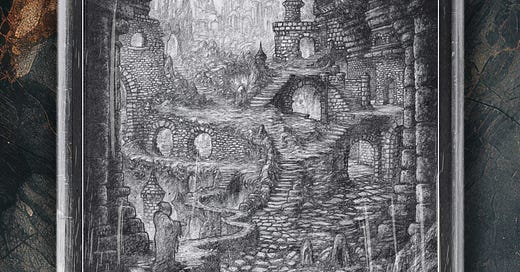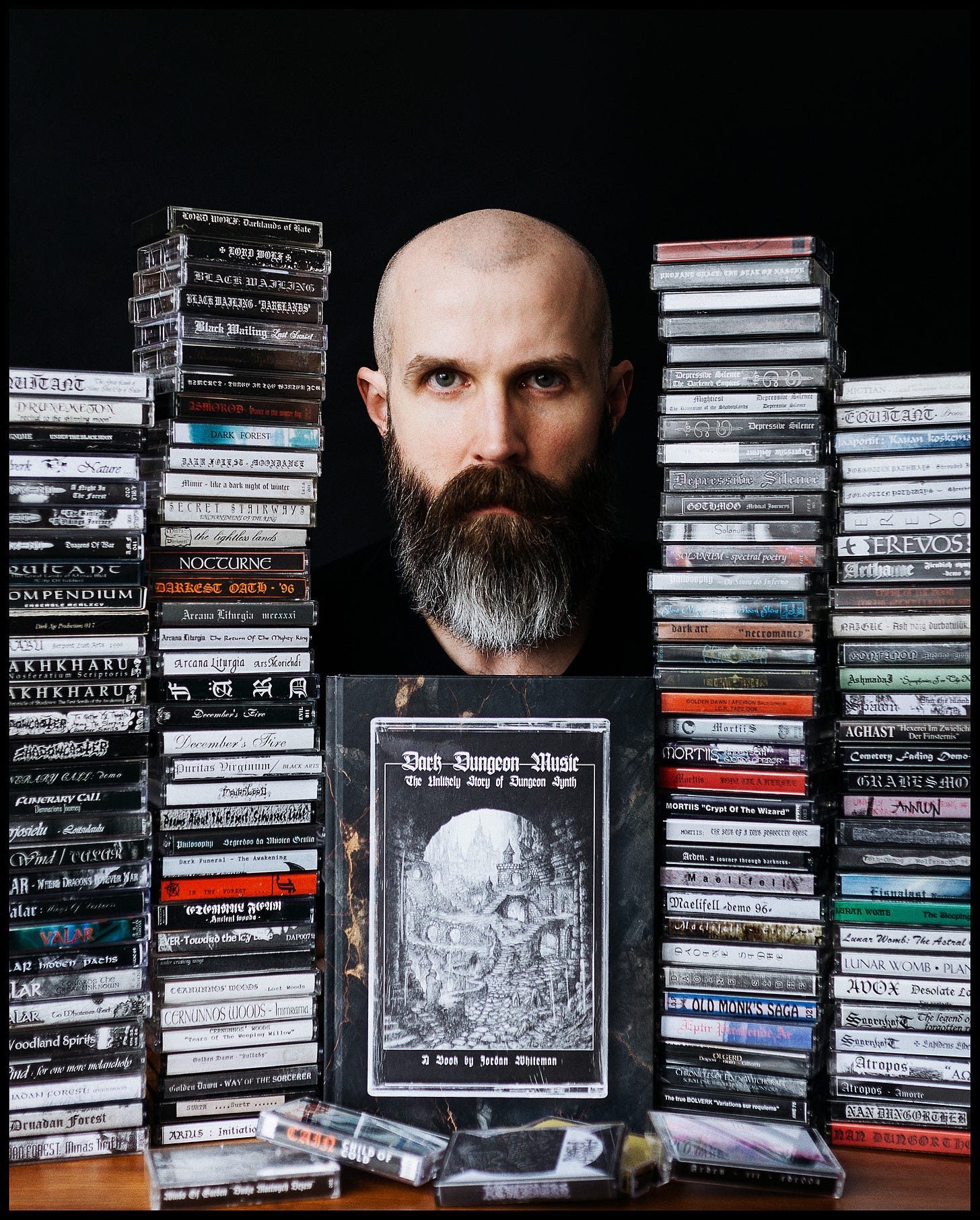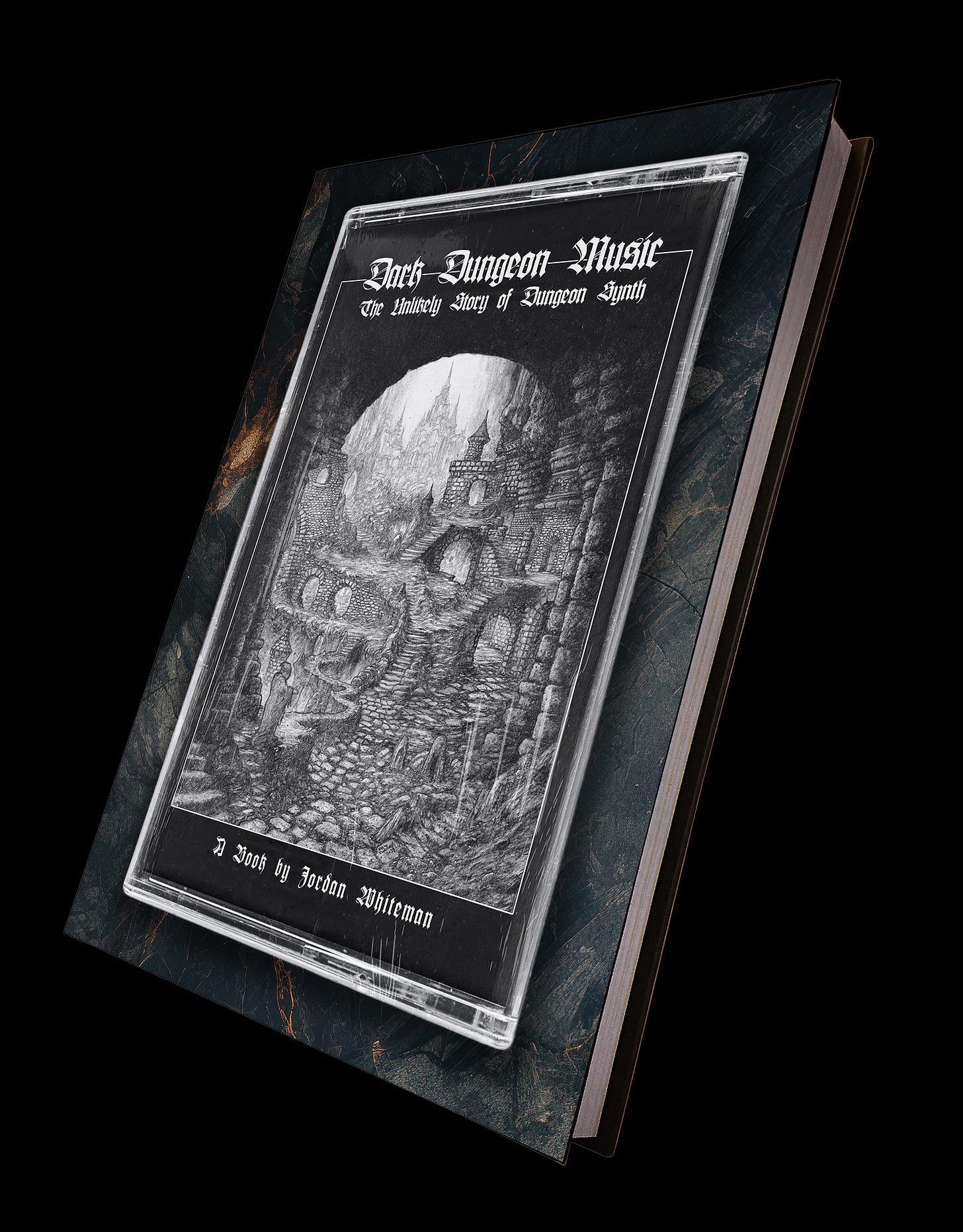'Dark Dungeon Music - The Unlikely Story Of Dungeon Synth' - book review and interview with author Jordan Whiteman
Over 300 pages that will make you a dungeon synth expert - but better yet, a fan.
Fortunately, it’s been a while since we were all wowed by sort of pioneering books on the history of metal and its subgenres - and associated genres too - like Daniel Ekeroth’s ‘Swedish Death Metal’, Albert Mudrian’s ‘Choosing Death’, or the first few steps of Ian Glasper’s wonderfully prolific book-writing career, just to name a few examples. Ever since those and a couple of others paved the way, there’s been a delightful excess of tomes chronicling the misadventures of bands, genres and movements. Despite the literary deluge, there are still, however, a few stones left to unturn, and one of the most glaring ones was dungeon synth. Not only because it’s a delightful not-so-little world that has gained a lot of attention and popularity in the last few years, but also because it’s been a style very prone to misunderstandings and misappropriations, even more than usual in these things.
Enter Jordan Whiteman! A lifelong, devoted fan of the genre, not to mention an active participant in the scene as well with the record label he operated, Ancient Meadow Records, it would be hard to find someone so validated and appropriate to tell the full story of dungeon synth as it deserves to be told, as he does on ‘Dark Dungeon Music - The Unlikely Story Of Dungeon Synth’, which you can get now from Cult Never Dies.
Fortunately, turns out Jordan is an excellent writer and journalist too - his prose is clear and engaging, never shying away from voicing his opinion when it feels relevant to do so, and the many interviews that constitute the bulk of the book are also superbly conducted. The decisions on how to structure the book are wise, and it will satisfy both the lifers and the absolute newcomers alike - from surprising descriptions of the actual gear typically involved in making music with these characteristics, to the connections with other genres and even a section on physical “relics” related to the music, it all makes for a varied and very complete read.
On one hand, you can come at it with zero knowledge of what dungeon synth is and you’ll emerge an expert, while on the other hand, no matter how much dedication you have to this fascinating scene, the many details, nuances and sheer breadth of of info to absorb from all your favourite artists, including some of the more reclusive (as is common within this often solitary genre) that Jordan managed to track down against all odds, is such that you’ll be immensely entertained and learn a whole bunch anyway. The richness of the photographic archive unearthed and the constant, delightfully nerdy lists and recommendations show not only a remarkable attention to detail, but also an immense, true love for the music, which is really all we can ask for on something like this. No matter what your thoughts are about dungeon synth, this comes highly recommended.
Naturally, we had to sit down with the author and ask him a few questions of our own. Read on for the really cool chat we had with him. Thank you, Jordan!
“I think the central message of this book is that this genre has a very, very dense history and most of it was before it had a name everyone agreed on.”
— Jordan Whiteman
You are obviously a “veteran” supporter of dungeon synth, what with your activity with Ancient Meadow and everything. When did the idea of writing a book about it first enter your mind?
Jordan Whiteman: I vaguely remember considering the idea almost as soon as I started my label, so that would have been 2017. I was obsessed with the genre, so I couldn’t get the idea out of my head, but I didn’t start writing it until around 2020 or so.
When did you first get into dungeon synth yourself? What was the first record, that first moment when you realised, hang on, this is my jam?
Jordan: I’ve been a black metal fan since I was a teenager, so I knew black metal records had those really contrasting parts with pianos and synthesizers in between the BM tracks. Of course, that meant I was familiar with the V.V. prison albums, but I was ambivalent towards them when I was younger. I discovered the phrase “dungeon synth” and its online communities in 2016 while searching YouTube for a BM record. In the suggested results was the album upload for Thangorodrim’s ‘Taur nu Fuin’, and that put me on this journey.
Was all the knowledge you gathered while running the label essential to the outcome of the book, would you say? Were there things that you experienced that you simply wouldn’t have as “just” a fan of the genre?
Jordan: Yes, absolutely. Despite my reputation, my label actually represents a large swath of music that is not pure dungeon synth, but I did reissue several classic albums and demos. Researching some of those, like Arthame’s ‘Fiendish Symphonies’, Valar’s ‘Towards the Great Unknown’, or the Depressive Silence discography really appealed to me. Doing those reissues showed me how much I enjoyed the idea of “music archaeology” and researching the very obscure history of this music. That led me to make several new friends, discover lost demos and zines from the ‘90s, and several other experiences that I would not have had otherwise.
How difficult was it to plan the whole thing? Did you plan/outline the format and various sections of the book beforehand, are you an “organized” writer, so to speak? And was it a long process? I suppose the interviews and reaching out to bands was the lengthier part of it all.
Jordan: I wrote the book over the course of a few years. I wrote around thirty thousand words and then threw them out and started over somewhere early on in that process. There were several chapters that I knew I wanted to write, like the chapter on industrial music, the one about gear certain artists were using in the early years, and the chapters on some of the cool relics I had acquired over the years. In that way, the chapters are really vignettes on specific topics relative to the development of the genre. I just started writing them, some of them concurrently, and with no particular sequencing in mind. I was sending huge chapters, some of them twenty to thirty thousand words in length, over to the publisher. They did well to break those up into digestible chunks. The most time-consuming part was really how much I wanted to put into this book. My initial vision was impossibly large. I wanted an exhausting book that showcased how this genre has consumed me over the past eight or so years. There were several chapters that I opted to leave out for different reasons. I conducted the interviews in tandem with writing the chapters for the book, with some being very recent and others dating to around 2020 when I started writing it. In retrospect, it was a frenetic and taxing period of my life.
Speaking of that, I’m sure you found a lot of obstacles. I know from experience that a lot of people in this genre are notoriously reclusive and/or unwilling to talk about their work, especially those that were around in the 90s. Were there any disappointments, people you just couldn’t reach or get to talk and stuff like that?
Jordan: There definitely were problems to solve and obstacles to overcome. You’re absolutely right about navigating some of the personalities. I expected that. It’s music and it’s a thing that attracts complicated creative types like any other form of art. There were a couple of people who I really wanted to have in there, but they just couldn’t muster the energy or will to agree to it. There is one specific artist missing from the interviews who is featured heavily throughout the book, I won’t say who because they’re my friend, but it would have been great to have an interview with them in there. They were a juggernaut of the music in the late 1990s.
On the other hand, were there artists that you got to, that you might have thought beforehand it would be difficult to? Is there someone in there that makes you particularly proud of being included?
Jordan: Absolutely. I am very proud that I was able to get Aslan of Floral of Forever/Noiratasya/The Mystickal East in there. He was so isolated from everyone else making this stuff in the 1990s, and yet he managed to make some perfect examples of this music anyway. I’m also proud to have so many of my friends in there. The majority of the interviews are people who I have come to know and call my friends over the years. While I feel they’re all exceedingly important to this music, it was nice to share this opportunity and have them join me in the process and be a part of it in a different way.
I think a lot of people will be surprised at the sheer size of the dungeon synth world. I think many recent fans of the genre might not even be really aware of the amount of artists and ramifications that are a part of the genre’s history. Over the course of your research and writing, were you at any point overwhelmed, did you have any “I can’t do this” moment at any point?
Jordan: Man, I remain overwhelmed by it. I think the central message of this book is that this genre has a very, very dense history and most of it was before it had a name everyone agreed on. I put years of energy into studying the 1990s and I feel like there’s still so much more that I have not discovered or adequately researched. I didn’t have the time or energy to devote that same level of research to the stuff from the 2000s. For a long time, myself and several of my friends were under the impression that there just wasn’t a lot of pure dungeon synth being made in those years. There were a few artists who bridged the gap from the 90s to the 2000s, but the overwhelming majority of the music from that era has not been adequately documented. Over the past year or two, some of my friends have started to comb through and uncover some excellent examples of this music from that era that were previously unknown to most of the crowd.
As a genre, in my opinion, it’s also very much still prone to misunderstandings and misrepresentations, and you actually touch a bit upon that in the book – do you feel that this massive work might be a step in helping to fight that and clarify things for people with just a passing knowledge of the genre? Was that actually part of the motivation to write the book in the first place?
Jordan: That was not the central motivation, but I do try to address some of the more troubling claims that I have heard over my years around this stuff. I did not always do that gracefully, so I wish I had the foresight to change some of that now that it’s out there. I do hope that it helps to steer people in the right direction if they want to take a deeper look at this music. Right now, there’s just too much to see and hear. It can be confusing for fans both new and old. When that happens in music, it becomes necessary to be more scrupulous and start defining music with more specific language. I feel it gives everyone a fair shot at reaching the right audience in a very noisy and crowded genre.
Do you think you might add to the book, for forthcoming editions of it?
Jordan: I’m undecided. Now that it’s out there and the fog of editing and racing to meet deadlines is gone, I have made a small list of things in there that I wish I had changed. Ultimately, the publisher owns the book, so they can keep printing it if they want. They were good to me, though, so I’m sure they would give me the opportunity to revisit the content in future editions. This was actually my third book, but the first non-fiction book I wrote. I have another book on dungeon synth planned with a friend of mine, but it will be more of an exposé of the genre in print media in the 1990s. Other than that, I think I’ll go back to writing fiction.
I won’t ask you for lists or anything like that – there’s enough material for list-building in the book itself, so everyone go read and make your own lists! – but it would be awesome if you could point us to some “dungeon synth for dummies” kind of playlists, something the uninitiated can just press play now and get a general idea for what fascinates you and so many others.
Jordan: There’s a ton of excellent stuff being made today. So much that it’s essentially impossible to document it all in a coherent way. There are a few YouTube playlists maintained by people I know that really exemplify the genre. When asked about this stuff, I usually just share those playlists:
- “Dark dungeon synth”
- “True Dungeon Synth”
- “The History of Dungeon Synth”
‘Dark Dungeon Music - The Unlikely Story Of Dungeon Synth’ by Jordan Whiteman is available now from Cult Never Dies.
Want to help us and the bands we cover keep the lights on, and get an exclusive tote bag to show for it? Become a subscriber of TDM and we’ll send you one, free postage worldwide. Also, never miss a post again (‘cause you’ll get ‘em in your inbox) and access our subscriber only posts. Get on it:
Also, don’t forget to invite your friends over, and you might win stuff.









